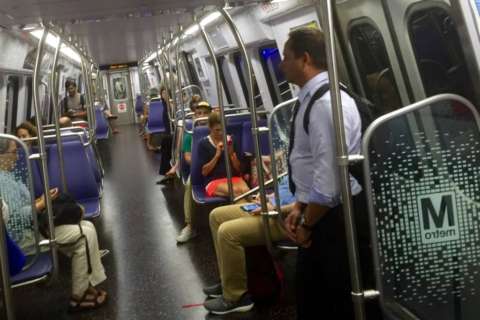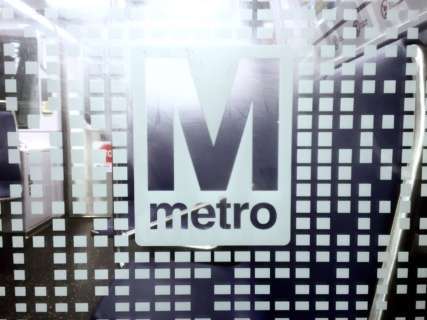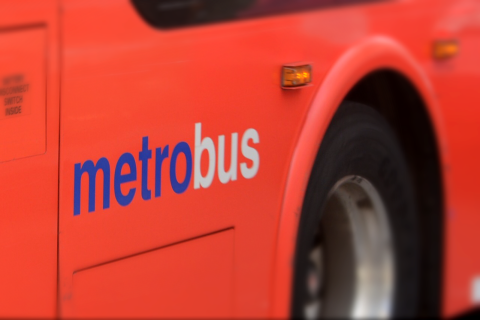WASHINGTON — Alexandria leaders are extremely worried about the monthslong shutdown of the Blue and Yellow lines set for this summer, and are considering a series of additional mitigation measures, including increasing HOV lane requirements and creating new slugging locations in the city.
All stations south of Reagan National Airport are scheduled to be closed from May 25 through Sept. 2 for platform repairs and other track work.
Metro hopes to finalize alternatives for riders within the next few weeks that would be meant to handle about two-thirds of current weekday rail trips in the area with 85 buses from a private contractor.
Metrobus and other local services could add to that on the first weekday of the shutdown, since Metrobus service planning head Jim Hamre said shuttle bus usage has been about 25 percent higher on the first day of Metro’s 24/7 shutdowns than the average later on in work zones.
Shuttle buses have been plagued by long lines, delays and confusion for riders on the first day of previous shutdowns, which may drive people to other options. Alexandria Mayor Justin Wilson worries those additional options, such as extra telework, may not work this time, given that the shutdown will last a few months rather than a few weeks.
“The scope and duration of this is, quite honestly, a bit unprecedented,” Wilson said. “I really caution you against kind of relying on the experience in a shorter duration closure for a closure that’s going to last the entire summer.”
Wilson said he worries it is “wildly optimistic” to believe the extra trips not handled by shuttle buses will be handled through transit or telework, so traffic is likely to get worse without clear communication about additional options.
“Folks can find alternatives for two weeks; they can’t find alternatives for three months. You’re going to have to rely on the system to work,” Wilson said.
There is a similar shutdown in the area this weekend and again the first weekend in March.
Metro still plans to set up weekend shutdowns and other long-term work zones elsewhere in the system during the summer shutdown.
New commuter parking, HOV requirement boost, water taxi
The city is hoping to shift at least some people to carpools or van pools, including by taking advantage of larger, underused parking lots in the city that could become commuter parking lots for slugging, carpooling or vanpooling during the shutdown.
Those travelers could then take the 395 HOV lanes or use Washington Street HOV lanes that would change from an HOV-2 requirement to HOV-3 to help buses and encourage bigger carpools.
Water taxi service expansion is also an option, but that has proved more difficult to figure out due to the costs.
“We are working closely with the riverboat company to determine whether we can add both additional commuting service, how we can market to visitors, but the issue right now is that we’re still in negotiations,” Alexandria transportation director Yon Lambert said.
Existing alternatives for Metro riders or people looking to avoid the increased traffic include Virginia Railway Express and bus routes such as Metro’s 11Y, 10A, 8Z and 21A.
The city is also looking at how to handle the nearly 50 private shuttles from hotels, apartments or other places that currently drop off and pick up at Metro stations. While some will still drop people at stations to use buses, Alexandria is also talking to Arlington about securing space for some of the shuttles to pick up or drop off at Crystal City, where trains will be running.
Noise concerns, street closures
The construction will also create noise concerns, given how close the tracks are to homes and businesses.
“24/7 construction, so day and night shifts at each station where they’ll be doing platform work and multiple lengths of track within the city,” Lambert said.
There will also be some lane closures on streets next to or below the tracks in some areas.
Metro is still sorting out exactly what routes the shuttle buses will take between stations. Typically, Metro has used West Street and Eisenhower Avenue for weekend shuttle buses.
Shuttle bus capacity, travel time
Metro plans shuttles through King Street and Braddock Road that can carry around 2,000 people around 8 a.m. Over the entire morning rush, 17,000 riders typically board at closed stations.
During a 2016 shutdown near Pentagon City, Hamre said, Metro carried 25,000 people on shuttles on its busiest day as riders waited in long lines. This fall, when riders faced long lines for shuttles on Veterans Day weekend with the closure of the Reagan National Airport Station, Hamre said, Metro carried 19,000 people on shuttles. Again, people waited in extremely long lines at Reagan National and elsewhere, or simply gave up and took a cab, Uber or Lyft. Hamre said Metro added 10 buses to the shuttle routes over a few hours as the situation got worse.
When shuttles are working normally, a good rule is to double the usual travel time, Hamre said. “Of course, if you choose to travel at 8 a.m. in the northbound direction it might take longer than that.”
Shuttles face additional challenges due to the continuing closure of the King Street bus loop and parking area for upgrades.
“Our key is being able to successfully manage the main terminal where the transfer’s happening — Crystal City,” Hamre added.
New bus bays there could help load more buses more quickly at Crystal City to provide a less hectic and crowded experience.
During a briefing this week, though, several members of the Alexandria City Council questioned whether enough information is getting to riders soon enough. Metro said it has hired contractors to help and plans to run some paid ads too.
Councilman John Taylor Chapman worries it may already be too late to reach visitors, since he had someone call his tourism company about booking for August, and could not give them accurate information.
“I have no way to know how they get to Alexandria, and that’s ridiculous. I need to know that now,” he said.
It contributes to a likely decline in visitors during the shutdown.
While the platform repairs and other track work is critical, Wilson said the shutdown could take millions of dollars more out of Alexandria’s economy if not properly managed.
“This is a fragile business environment we’re already in. This will put businesses out of business,” Wilson said.
The city’s contributions to alternatives are not yet finalized, but options on the table could cost Alexandria up to $750,000. The state could reimburse some of those costs.
Improvements would include better bus shelters and sidewalks around bus stops, and varying levels of outreach, marketing and additional services.







